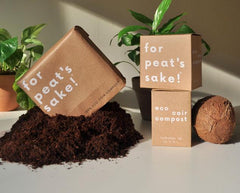SKY PLANTER FAQS
How do I plant my Sky Planter? Simple planting instructions are provided with every Sky Planter. You can also watch the short video demonstration on the Product page.
How do you stop the soil falling out? A simple locking disc or ceramic collar fits around the stem of the plant and connects to the planter body with small tabs, much like a tea pot lid. A plastic mesh is also included that can be cut to fit around the plant stem and sit on top of the soil as added protection against soil falling. Our several years of testing has found that a small amount of soil may initially fall out when the Sky Planter is first hung, but it will quickly compact and stabilise.
How do you water the Sky Planter? A porous ceramic reservoir sits at the top of the Sky Planter and connects with the soil. It’s filled through a small hole at the top of the planter and water is gradually released into the soil by diffusion. This means most of the water reaches the plant roots directly, reducing evaporation and conserving water. It also means you’ll only have to fill the reservoir when it’s empty, saving time. Ensure there is a good connection between the reservoir and soil for the water to flow sufficiently. Depending on the size of your Sky Planter, your climate and the type of plant you’ve chosen you’ll probably only have to water every week or two.
What sort of plants are best suited to the Sky Planter? The Sky Planter will grow a wide variety of common house plants. For optimal air-purification and hardiness we recommend Kentia and Areca palms, Anthurium, English Ivy, Peace Lily and Rubber plants. Many kitchen herbs will thrive and you can even grow your own vegetables. Experiment with your favourite plants and see how they adjust to a life upside down!
How should I optimise my plant's health? Conventional planters can be fed with granulated plant food. However, we recommend you use diluted water soluble plant food for your Sky Planter as granules will not release into the soil. Your local garden centre will be able to advise on a suitable food for your plant variety. You’ll still need to tend to your plant as usual and remove dead leaves and flowers, mist the leaves and wipe off dust.
How is growing plants in a Sky Planter different to a conventional planter? The main difference is in the watering system. With a conventional planter you need to water plants regularly, and almost daily in the height of summer. In contrast, the porous reservoir of the Sky Planter regulates the amount of water that is fed directly to the plant roots depending on how dry the soil is. The more water absorbed by the plant from the soil, the faster the water flows from the reservoir to the soil, and the more frequently the reservoir will need to be filled. Over time, if you monitor the level of water in the reservoir you will learn how often it needs to be refilled to maintain the health of your plant. Some plants prefer a dry spell between watering, so you can simply leave the reservoir empty for a few days.
Where should I hang my Sky Planter? The Sky Planter creates a vibrant interior design feature in any home or office – an empty corner or kitchen spaces are popular choices for your upside down planter. When choosing where to hang it, also consider the health of the plant. Some plants like a lot of light while others prefer shade. For advice on the light requirements of our preferred plant varieties click here. Make sure your ceiling surface is sturdy and free of hazards such as plumbing or electrical wiring. Avoid suspending the Sky Planter above electrical equipment or furnishings in case of overfilling or occasional drips. And please, keep out of reach of small children.
How do I install my Sky Planter securely? You need to install the ceiling hook into a solid base. The ceiling hook and plastic anchor plug provided are suitable for solid ceilings made from wood or concrete. They are not suitable for suspended ceilings or for plasterboard. If you have a non-solid ceiling, visit your local hardware store and ask about the best solution for your home. Install the Sky Planter away from strong wind currents to minimise breakage. Please seek professional advice if you are unsure about installing your ceiling hook and planter safely.
Can I use my Sky Planter outdoors? The Sky Planter has been designed for indoor use but you can install it outdoors as well. You will need to be careful that it is protected from strong winds. You’ll also need to select an appropriate outdoor plant that likes full sunlight to maintain optimum plant health. During summer, pay close attention to the water level of the reservoir. It is likely to empty faster than your indoor planters because of higher temperatures.

